- Photo essay covers what is Purdah, What is Ghoongat, Why Turban is not Hijab, Can girls in a government aided school wear Hijab, Origin of Sikh Turban & Pictures of Hindu women across India to know social realities.
I am
grateful to controversies like Were
Cholas Hindus, Saivism
and Vaishnavism because they force us to read up and revisit issues. This article is triggered by the recent Supreme Court (SC) split order on hijab.
The words burqa, hijab are used together so often one gets confused about what is what.
1. What is Hijab and difference from Burqa?According to this firstpost.com
article, “The word hijab itself describes the act of
covering up. It is a head scarf that covers the head and the neck but leaves
the face uncovered. Nijab is a veil
that covers the head, neck and most of the face, except the eyes. Burqa-Unlike a niqab, a burqa covers the face entirely while leaving a mesh screen in front of the eyes.”
In desert
regions, like the Middle East where Islam originated, Burqa protected women
during sandstorms since it covers the body and has a mesh screen in front of
eyes. In India, men prefer to wear dhoti/veshti and women single layered cotton clothing that is better suited to the country’s climate.
2. The commonly used word is Purdah (veil). What is it?
The word
Purdah is Persian. It means
Curtain.
“Purdah’ is a Persian word translated as curtain, veil, attire worn by women to mark their social and physical segregation from the rest of society by covering their bodies and/or faces. Purdah takes different dimensions depending on the country, place of origin and hence–has numerous variations. The physical expression of purdah translates into zenana (women living in separate quarters), burqa/chadar (veiling by a garment), ghoonghat (covering the face) and certain other.” Source
Inbreakthrough.org
The
Zenana Mahal (separate quarters for women) exists in City Palace Udaipur (made
early 1600s) and Chittorgarh Fort (made
16th century) etc.
3. What is the origin of Purdah?
“In his well-known book, Medieval India, renowned historian Satish Chandra writes that during the Delhi Sultanate period starting 1206 the practice of keeping women in seclusion and asking them to veil their faces in the presence of outsiders became widespread amongst the upper classes of women. He says the Arabs and Turks brought this custom to India and it was then widely prevalent in North India. Chandra writes that “the growth of purdah was due to the fear of Hindu women being caught by invaders’ as trophies of war.” Source Times of
India
According to Volume 6 (1300-1526 A.D.) of The History and Culture of Indian People, “What is certain is that the peculiar social conditions in India were largely responsible for the development of this system which was unknown in other Muslim countries in medieval times.” Pg. 609 Further, “The purdah or seclusion of women had already become a common practice. This is evident by the remarks made by contemporary historians and poets on the bold step taken by Sultan Raziya in discarding the veil and dressing herself up in male attire.” 2 Pg. 608.
Also read
excerpts from ‘The Status of Muslim Women in Medieval India’ by Sudha Sharma; SAGE Publications), “The Muslim men were very zealous in guarding their women from public gaze and considered it a dishonour if they were exposed unveiled. Monserrate, mentioning about harem ladies of Akbar’s time, wrote that they ‘are kept rigorously secluded from the sight of men.” “In medieval Indian society, purdah was common with the Muslim ladies. Strict purdah originated with Amir Timur, when he conquered India and entered in this country with his army and womenfolk. He made the proclamation, ‘As they were now in the land of idolatry and amongst a strange people, the women of their families should be strictly concealed from the view of stranger.” Source
HansIndia.com
My
Dadaji said that the tradition of Punjabis (may be others too) of having
weddings at night was because during Muslim rule, marriages held during the day
ran the risk of the bride being abducted by invaders because she could be seen
(there was no electricity). At night travelling was difficult.
Ghoonghat is very different from Hijab, Nijab and Burkha. Purdah is adopted before a girl gets married amongst Muslims. For Hindus, ghoonghat (followed in parts of North India) invariably happens post marriage.
4. What is Ghoonghat?
Ghoonghat is the veil that covers the face. It may be the saree, odhni, chunni etc. i.e. part of the outfit that a lady is wearing.
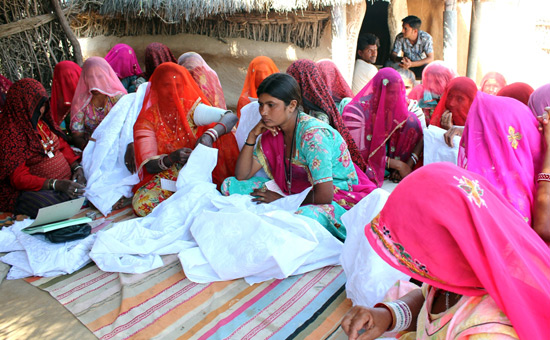 Ladies in a village near Barmer, Rajasthan with ghoonghat. Most used Chunni to cover their face. 2013.
Ladies in a village near Barmer, Rajasthan with ghoonghat. Most used Chunni to cover their face. 2013.
5. Hijab/Purdah referred to in the Vedas as per this link
The word Purdah being a Persian is not to be found in the Vedas. The link does not quote the Rig Veda verse in Sanskrit but quotes an English translation.
A lot can get lost in translation for e.g. the word ‘Dharma’ is translated as religion when Dharma means something entirely different. So also many consider the word ‘Hindustan’ to be an equivalent of ‘India’ when it means the Urdu-speaking areas of the Indian sub-continent. Moreover, verses cannot be read in isolation as shown by Arjun’s response to above referred translation. Read here
Every
language has a cultural context. Can a Persian word have a Bharatiya context? Also read History
of Urdu
This
aside, the question to ponder over is Does
any Temple depict women in Purdah and do Hindus of today follow it across India
like Muslims do? Read on.
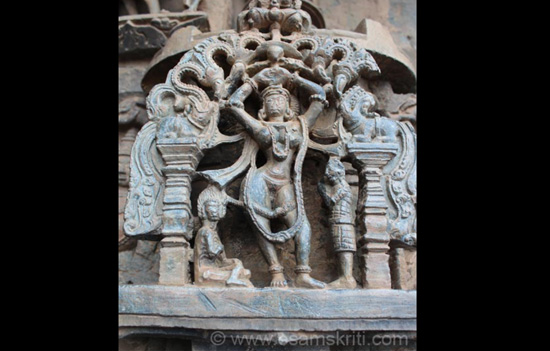 Bracketed figures in Belur Temple called Madanikas.
Bracketed figures in Belur Temple called Madanikas.
To see temple album with more
Madanikas.
If the Rig Veda indeed referred to Purdah would India have a rich and diverse dance tradition which is dominated by women? India is perhaps the only country that worships God as Mother. Have you seen pratimas of Shakti veiled with purdah?
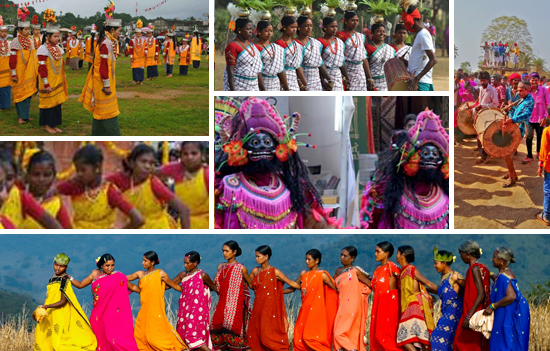 Adivasi Dance.
Adivasi Dance.
 Khajuraho Dance Festival 2021. Pic by Dr Priyaanka Mathur.
Khajuraho Dance Festival 2021. Pic by Dr Priyaanka Mathur.
Also read Khajuraho
Dance Festival, An Ode to Abhinaya, Natya and Bhav N Adivasi
Dances of India N Worship
of God as Mother in Indian Tradition
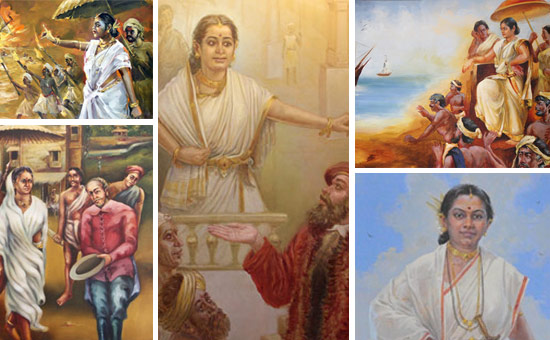 Warrior Queen Rani Abbaka Chowta, Karnataka 17th century. Purdah!
Warrior Queen Rani Abbaka Chowta, Karnataka 17th century. Purdah!
6. Another commonly heard statement is that Purdah was used by
upper classes?
Since
it was mainly Kshatriyas who fought wars then, it was their women who were targeted when wars were lost to invaders. Author Jeffrey Long wrote that the concept of traditional Hindu war is very different from modern warfare. To read more War
and Non-violence in the Bhagavad Gita
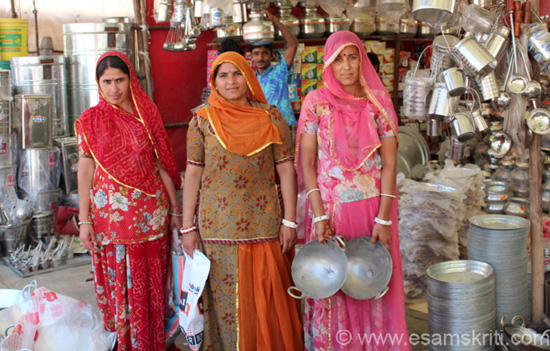 For me to click Rajput women removed Ghoonghat. Nagaur Cattle Fair 2013.
For me to click Rajput women removed Ghoonghat. Nagaur Cattle Fair 2013.
7. So what is the issue in Karnataka?
The matter before the SC is whether school going girls can wear
hijab in a government aided school and NOT a complete ban on Hijab.
According to this Indian Express
article, “In 2013, under Section 133(2) of the Karnataka Education Act, 1983, the state had issued a directive making uniforms compulsory for education institutions. Referring to the 2013 directive, the latest directive specifies that a headscarf is not part of the uniform.”
If follower of every faith in the Indian Army, a hospital or employees of a private sector firm which has a uniform, says that colour of uniform must reflect their faiths think of the chaotic consequences!
In Maruti Suzuki the uniform is grey pant and light blue shirt for men.
If Muslims say they will wear only a green shirt then! Will companies hire
them?
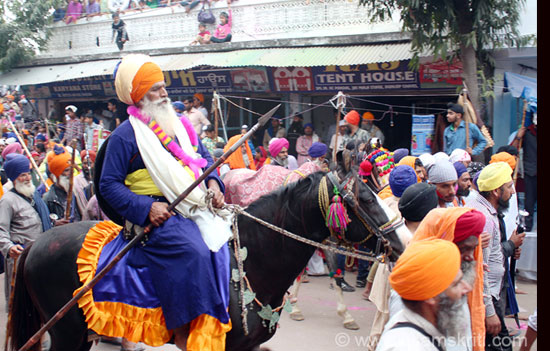 Turban and Beard protect head of warrior.
Turban and Beard protect head of warrior.
8. A question on Twitter, if Turban can’t be banned why Hijab?
In response, senior columnist Tavleen Singhji tweeted, “The turban is not a symbol of the repression of women. The hijab is.”
Actually the two are not comparable. Turban is worn by
men and hijab by women. Moreover, Sikhs started wearing turbans only after
1699. Here is why -
On 30 March 1699, at Anandpur, the 10th Guru
Govind Singhji founded Khalsa. Its followers had to sport the five Ks i.e. Kesh
(long hair), Kangha (comb), Kirpan (sword), Kara (steel bracelet), Kachcha
(knickers).
The turban helps Sikhs manage their hair. However, in 1699 the reasons were different. Long hair and turban helped the Guru give his followers a unique identity and more importantly, protect their faces and heads from sword-cuts and lathi- blows. Kangha or comb
was required to keep beards in proper shape so they looked impressive and
manly.
According
to this article in The Week, “The 16th Generation descendant of Guru Nanak, Baba Vikramaditya Bedi does not sport the 5Ks (includes growing of long hear and turban) because his great grand- father believed 5Ks were only for time of war.”
That
Turbans are an essential part of Sikh samprayadya got engrained in our minds because the British made sporting of the symbols of Khalsa, one of which is a turban, a pre-requisite for Sikhs who wanted to join the Indian Army. Few questioned colonial thinking post-independence!
Also read Why
was the first son made a Sikh
It is also not that wearing a turban is unique to Sikh tradition. One of Shiva's names in the Shiva Sahasranama is Ushnisha, meaning one who wears a
turban.
My great grand-father, a Punjabi Hindu using today’s connotations, wore a pagdi.
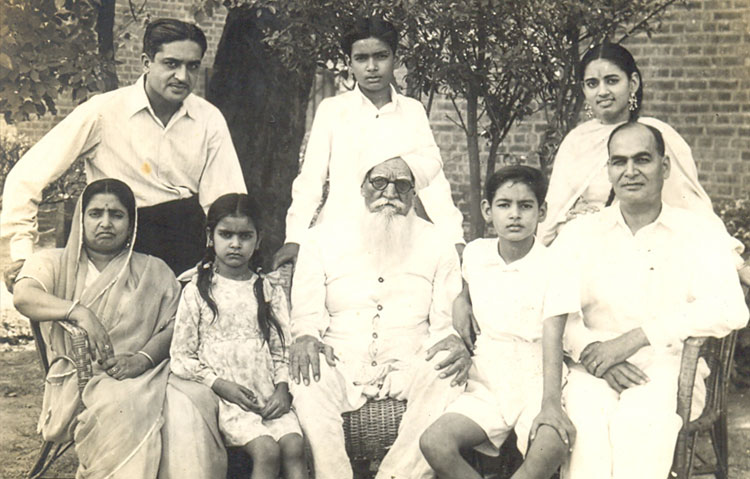 Author’s great grand-father. 1948.
Author’s great grand-father. 1948.
Also read Why
Sikhs wear Turbans
We
must know that people across India wear Turbans, the styles may vary.
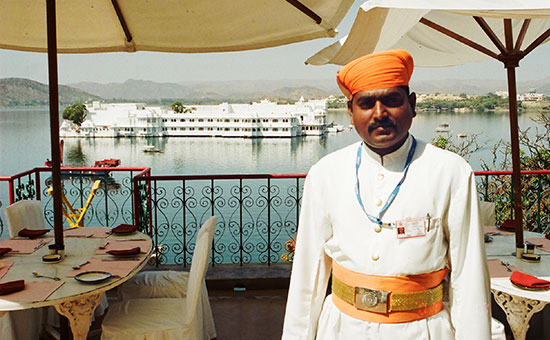 Pagdi Mewar style, City Palace Udaipur.
Pagdi Mewar style, City Palace Udaipur.
Also read About
Turbans of India
It has become the norm for some Sub-continent Muslims
to seek parity with Hindus on every issue. So, if hijab in government aided
schools must go its perceived equivalent ghoonghat must go too. Again the two
are not comparable.
9. What about covering of head by Hindu daughter-in-laws?
When the purdah system came into contact with “Hindu culture’s rural areas, it was translated as laaj.” A daughter-in-law would cover her head with pallu or dupatta in the presence of her
in-laws. This custom is seen today in traditional families and perhaps in rural
India.
10. Whilst evaluating any tradition it
is imperative to see how people live today?
Based on my all India travels here are pictures of Hindu women across India and observations. See and decide for yourself if ghoonghat is followed across India.
Village near Barmer, Rajasthan. When I entered their
home with local guide the younger ladies had no ghoonghat but on seeing me it came
on. However, their mother-in-law did not cover her face.
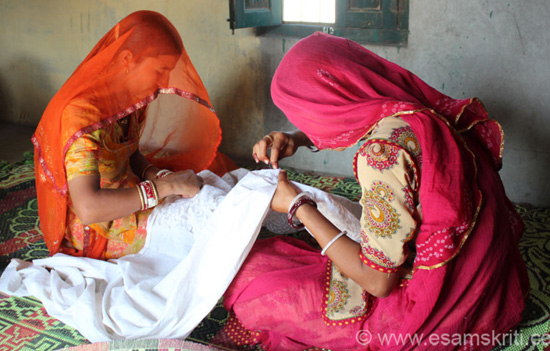 Younger ladies covered their faces on seeing a stranger that is me. 2013.
Younger ladies covered their faces on seeing a stranger that is me. 2013.
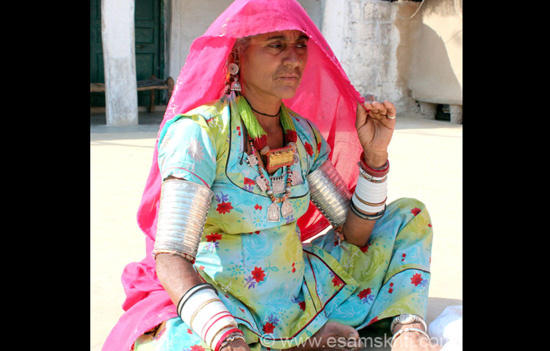 Their mother-in-law did not cover her face, being
much older. 2013.
Their mother-in-law did not cover her face, being
much older. 2013.
Next is the north Indian state of Himachal
Pradesh.
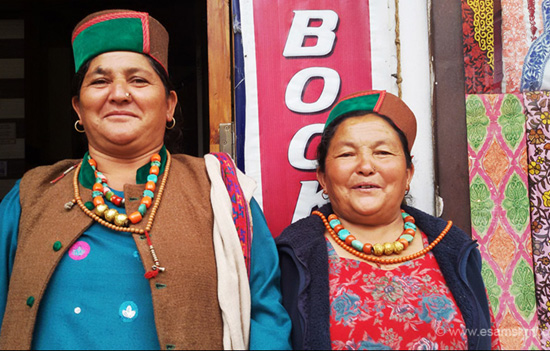 Women wearing Himachali Topi, worn by men too. Manali 2016.
Women wearing Himachali Topi, worn by men too. Manali 2016.
Also read The
Incredible Women of Bharat
In Kutch, I saw women Hindu and Muslim use a cloth to cover their head.
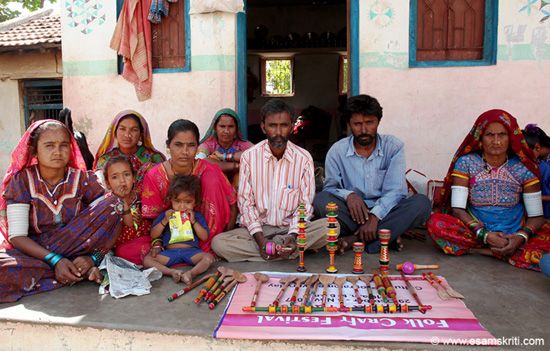 Family of Suresh & Jaytee Bhai, village Nirona,
Kutch, Gujarat.
Family of Suresh & Jaytee Bhai, village Nirona,
Kutch, Gujarat.
Near Along, Arunachal Pradesh, where I visited Vivekananda Kendra’s all-girls school.
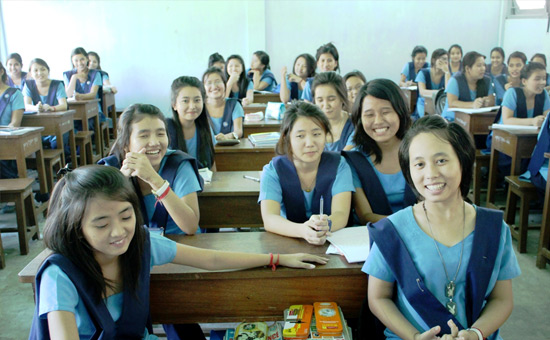 Students at Vivekanand Kendra, Jirdin in Arunachal. 2013.
Students at Vivekanand Kendra, Jirdin in Arunachal. 2013.
In the villages of Nandgaon and Barsana near Mathura, women use their sari pallusu to cover their faces during Lathmar Holi, where women beat men with a stick.
 Lathmar Holi, village Barsana, Uttar Pradesh. 2016.
Lathmar Holi, village Barsana, Uttar Pradesh. 2016.
Let us move to the North-eastern state of Nagaland.
Pic is girl of Kachari tribe, a non-Naga Hindu tribe i.e. also found in Tripura
and Assam.
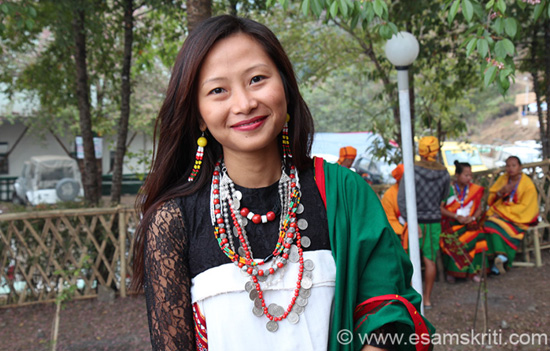 Kachari Hindu tribe. Hornbill Festival Kohima, 2014.
Kachari Hindu tribe. Hornbill Festival Kohima, 2014.
Also see Tribes of
Nagaland
All through my 19 day trip through Kumaon, I did not see any Pahadi woman (married or
unmarried) with a ghoonghat. These girls in a village near Munsyari.
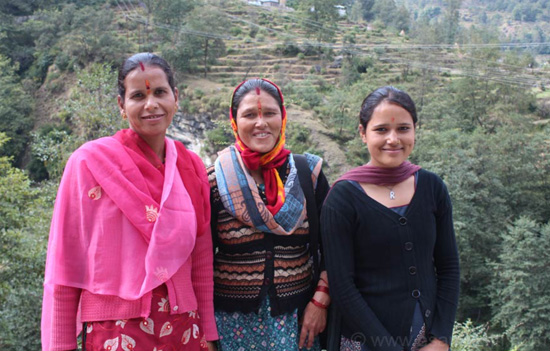 Girls in Kumaon village.
Girls in Kumaon village.
Also see People of
Kumaon
All through my 20 day's trip to Tamil Nadu, I did not see any Tamilian Hindu women with a ghoonghat.
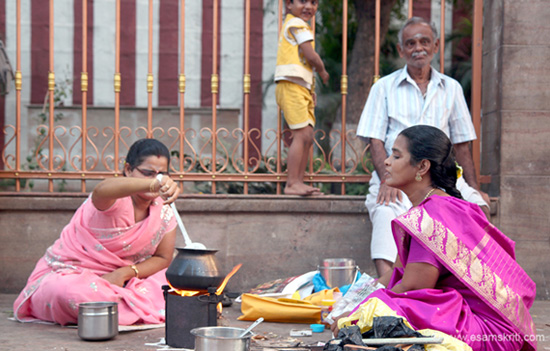 Cooking outside Madurai temple.
Cooking outside Madurai temple.
Also see Album
Women Flower-sellers outside Tamil Nadu temples
All through my five day's stay in Mysuru I did not see any Hindu woman with a ghoonghat. Though in Mysore Palace I saw Muslim women wearing sarees below their Burkhas.
 Dancers in Mysore Palace, Dussehra 2017.
Dancers in Mysore Palace, Dussehra 2017.
Coming to Maharashtra
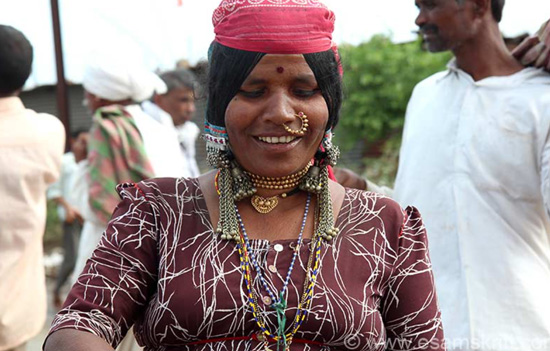 Banjara Adivasi women, Pandharpur, 2015.
Banjara Adivasi women, Pandharpur, 2015.
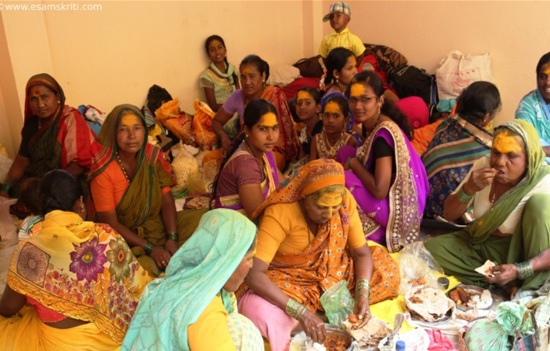 Maharashtrian women heads covered with pallu. South
Indian women not covered. Haldi festival, Pattan Kodoli village, Kolhapur 2019.
Maharashtrian women heads covered with pallu. South
Indian women not covered. Haldi festival, Pattan Kodoli village, Kolhapur 2019.
Covering head with sari is very different from hijab.
Based on the above pictures, can say that I found ladies with ghoonghats in rural Rajasthan and western Uttar Pradesh. Have not visited the interiors of Eastern U.P., so cannot speak about them. Friends say that women in rural Bihar esp. the richer ones, observe ghoonghat although their numbers are falling.
To conclude, ghoonghat
is limited to some parts of North India and reflected changes in society post
Islamic invasions.
This Hungarian Muslim Dancer was part of a famous
Kalbelia dancer group that performed at the Jaisalmer Desert Festival.
 Amazing performance by a Hungarian Muslim. 2013.
Amazing performance by a Hungarian Muslim. 2013.
The Supreme Court will decide the legalities. This
photo article gives a historical and social perspective. Use your buddhi and know the difference between ghoonghat
and Purdah.
Unless Indians get rid of British and Middle Eastern coloniality and understand Dharma, nothing will change.
Also read
1. Why Secularism is not an Indian concept
2. Hijab
order: 7 questions this verdict leads to
References
1. The History and Culture
of Indian People Volume 7, published by Bharatiya Vidya Bhavan.
2. The History and Culture
of Indian People Volume 6, published by Bharatiya Vidya Bhavan.
3.
India, Bharat, Pakistan by J Sai Deepak.
Article
must not be republished without written permission of www.esamskriti.com.
Unless indicated all pictures are clicked by author.